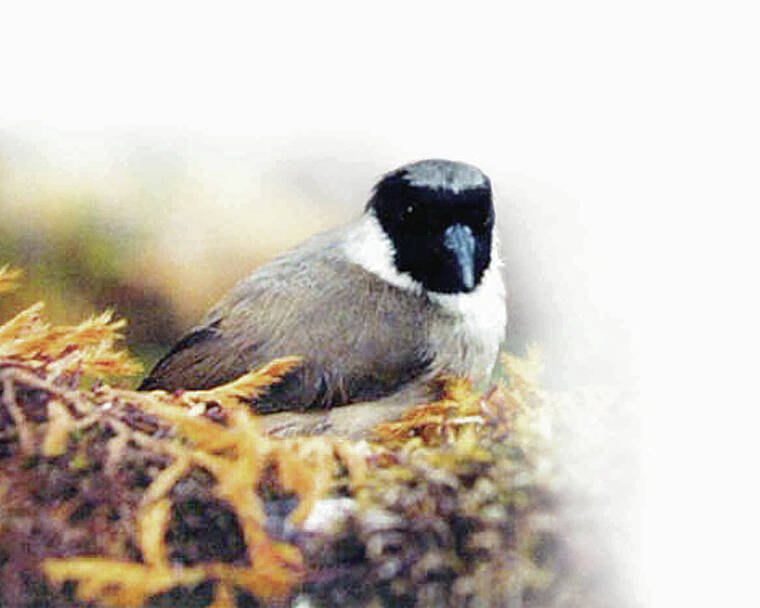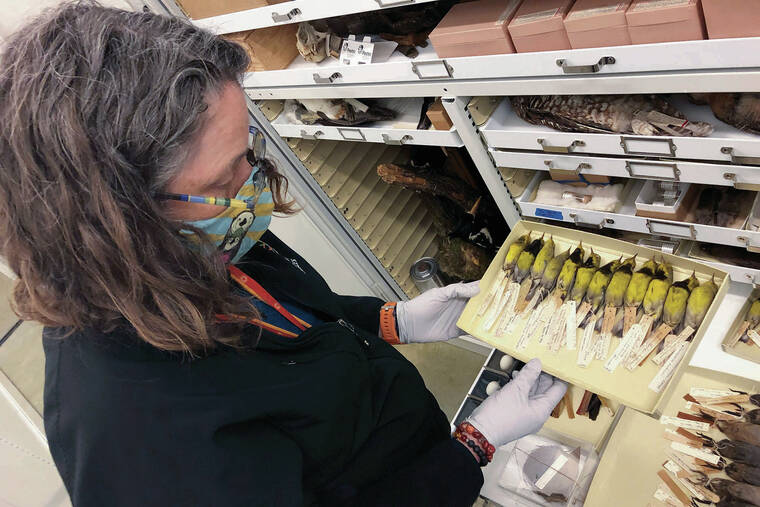U.S. says 8 Hawaii birds among nearly two dozen extinct species

STATE DIVISION OF FORESTRY AND WILDLIFE, FILE / AP
A po‘ouli, one of three known to exist in 2004, was shown then inside the Hanawi Natural Area Reserve on Maui. The teeny honeycreeper is now on the list of extinct species.

ASSOCIATED PRESS
Moe Flannery, senior collections manager for ornithology and mammalogy at the California Academy of Sciences, held a tray containing Bachman’s warblers in their specimen collection in San Francisco on Friday. Bachman’s warbler and 22 other species are now deemed extinct.


BILLINGS, Mont. >> Death’s come knocking a last time for the Kauai ‘o‘o and 22 more birds, fish and other species: The U.S. government on Wednesday declared them extinct.
It’s a rare move for wildlife officials to give up hope on a plant or animal, but government scientists say they’ve exhausted all possibilities to find these 23. And they warn climate change, on top of other pressures, could make such disappearances more common as a warming planet adds to the dangers facing imperiled plants and wildlife.
Hawaii has the most species on the list — eight woodland birds and one plant. That’s in part because the islands have so many plants and animals that many have extremely small ranges and can blink out quickly.
The most recent to go extinct was the teeny po‘ouli, a type of bird known as a honeycreeper discovered in 1973.
By the late 1990s just three remained — a male and two females. After failures to mate them in the wild, the male was captured for potential breeding and died in 2004. The two females were never seen again.
The other Hawaiian birds are the Kauai ‘akialoa, Kauai nukupu‘u, large Kauai thrush, Maui ‘akepa, Maui nukupu‘u and the Molokai creeper. The isle plant is a type of mint, Phyllostegia glabra var. lanaiensis.
Don't miss out on what's happening!
Stay in touch with breaking news, as it happens, conveniently in your email inbox. It's FREE!
Many of the species being proposed for delisting were already extremely rare or uncommon when discovered or when they were federally listed. Some like the Kaua‘i nukupu‘u had not been seen since 1899 and weren’t able to benefit from the conservation protections of the Endangered Species Act (ESA), according to the U.S. Fish and Wildlife Service.
Among states, Hawaii’s protective lists are the longest, with upwards of 500 plant and animal species currently designated as threatened or endangered.
The fate of Hawaii’s birds helped push Duke University extinction expert Stuart Pimm into his field. Despite the grim nature of the government’s proposal to move more species into the extinct column, Pimm said the toll would probably have been much higher without the ESA.
“It’s a shame we didn’t get to those species in time, but when we do, we are usually able to save species,” he said.
Since the passage of the act, 54 species in the United States have been removed from the endangered list because their populations recovered, while another 48 have improved enough to move from endangered to threatened. So far, 11 listed species have been declared extinct.
Islands, where wildlife evolved in isolation, have been especially hit hard by extinctions caused by humans introducing foreign species into the ecosystem.
Pigs, goats and deer destroy forest habitat. Rats, mongoose and brown tree snakes prey on native birds and bats. Mosquitoes, which did not exist in Hawaii until they arrived on ships in the 1800s, kill birds by infecting them with avian malaria.
Hawaii was once home to more than 50 species of honeycreepers, some of them brightly colored with long, curved beaks used to drink nectar from flowers. Taking into account the proposed extinctions in this batch, only 17 species are left.
Most of the remaining species are now under heavier siege. Birds that lived higher in the mountains were once safe from avian malaria because it was too cold for mosquitoes. But because of climate change, the mosquitoes have spread higher.
“We’re seeing very dramatic population declines associated with that increase in mosquitoes that’s a direct result of climate change,” said Michelle Bogardus, the deputy field supervisor for the Pacific Islands Fish and Wildlife Office.
Only a couple of species have shown resistance to avian malaria, she said, so most are likely to face extinction unless mosquitoes can be controlled over the whole landscape.
Climate change is also making species recovery harder, bringing drought, floods, wildfires and temperature swings that compound the threats species already faced.
How they are saved also is changing. No longer is the focus on individual species, let alone individual birds. Officials say the broader goal now is to preserve their habitat, which boosts species of all types that live there.
“I hope we’re up to the challenge,” Bogardus said. “We don’t have the resources to prevent extinctions unilaterally. We have to think proactively about ecosystem health and how do we maintain it, given all these threats.”
The ivory-billed woodpecker was perhaps the best known species the U.S. Fish and Wildlife Service declared extinct. The woodpecker went out stubbornly and with fanfare, making unconfirmed appearances in recent decades that ignited a frenzy of ultimately fruitless searches in the swamps of Arkansas, Louisiana, Mississippi and Florida.
The factors behind the disappearances vary — too much development, water pollution, logging, competition from invasive species, birds killed for feathers and animals captured by private collectors. In each case, humans were the ultimate cause.
Another thing they share: All 23 were thought to have at least a slim chance of survival when added to the endangered species list beginning in the 1960s.
A 60-day public comment period on the new batch of 23 begins today. . Scientists and members of the public can provide information they would like the Fish and Wildlife Service to consider before making a final ruling.
Around the globe, some 902 species have been documented as extinct. The actual number is thought to be much higher because some are never formally identified, and many scientists warn the earth is in an “extinction crisis” with flora and fauna now disappearing at 1,000 times the historical rate.
It’s possible one or more of the 23 species named Wednesday could reappear, several scientists said.
The International Union for Conservation of Nature, a Switzerland-based group that tracks extinctions globally, is not putting the ivory-billed woodpecker into its extinction column because it’s possible the birds still exist in Cuba, said the group’s Craig Hilton-Taylor.
Hilton-Taylor said there can be unintended but damaging consequences if extinction is declared prematurely. “Suddenly the (conservation) money is no longer there, and then suddenly you do drive it to extinction because you stop investing in it,” he said.
But wildlife officials said in an analysis released Wednesday that there have been no definitive sightings of the woodpecker since 1944 and “there is no objective evidence” of its continued existence.
They said the 23 extinction declarations were driven by a desire to clear a backlog of recommended status changes for species that had not been acted upon for years. They said it would free up resources for on-the-ground conservation efforts for species that still have a chance for recovery.
What’s lost when those efforts fail are creatures often uniquely adapted to their environments. Freshwater mussel species like the ones the government says have gone extinct reproduce by attracting fish with a lure-like appendage, then sending out a cloud of larvae that attach to gills of fish until they’ve grown enough to drop off and live on their own.
The odds are slim against any freshwater mussel surviving into adulthood — a one in a million chance, according to Ford of the wildlife service — but those that do can live a century or longer.
———
The New York Times and the Honolulu Star-Advertiser contributed to this report.



